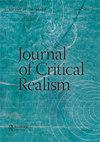Democracy and human nature: a layered system analysis
IF 2.9
0 PHILOSOPHY
引用次数: 0
Abstract
ABSTRACTThis paper addresses a question posed by the increase of democratic backsliding: whether democracy itself is compatible with human nature. It analyses democracy as a layered system consisting of three levels: the political/institutional, the social/interactional and the psychological/intrapsychic. At each level it uses evolutionary theory to describes features of a ‘light side’ of human nature that makes democracy possible, and of a ‘dark side’ of human nature that leads to democratic backsliding. At the political/institutional level these features are the reduction of reactive aggression and the capacity for the intragroup stranger. At the social/interactional level they are the cultural evolution of cooperative norms and an inclusive group identity. At the psychological/intrapsychic level they are the coherent, continuous positive self-experiences produced by shared positive emotions. However, these mechanisms can misfire at each level, producing the dark side that leads to democratic backsliding.KEYWORDS: Democracydemocratic backslidingcritical realismgroup selection theorycultural evolutioncooperation Disclosure statementNo potential conflict of interest was reported by the author(s).Notes1 The terms ‘light side’ and ‘dark side’ are used in this paper as an expository device. Although they do have a binary form, they should not be taken as suggesting that any particular political action can be simply fit into one category or the other. A more nuanced language that is beyond the scope of this footnote to elaborate is based on the big history tradition (Christian Citation2018). According to this tradition, human evolution is the result of collective learning, that is, group collaboration to develop and share concepts and information (Christian Citation2018). Patomaki, elaborates this basic thesis by distinguishing between progressive collective learning and pathological collective learning (Patomäki and Morgan Citation2023). Progressive collective learning involves learning processes that increase the learning capacity of a system, whereas pathological collective learning involves processes that reduce the system’s learning capacity. Put in these terms, the light side of human nature is the processes that increase our species capacity to collaborate, and the dark side is processes that reduce this capacity.2 A standard critical realist concept of structure and levels involves their ontology. A high-level structure exists when it emerges from complex interactions between activities of the entities constituting that structure. The higher-level structure then acts on its constituents by means of downward causation (Bhaskar Citation2016). Archer’s morphogenetic theory offers an example of this when Archer opposes analysing social structure as nothing but a global description of the agents who occupy that structure (Archer and Morgan Citation2020). My own view is that the levels theorized in this paper are emergent from the levels below them. For example, social identities at the social/interactional level emerge from the interaction of individuals at the psychological/intrapsychic level. In addition, these social identities can affect individual psychologies. However, some readers may view this conceptualization of levels as too simplistic and hierarchical (cf. Patomäki and Morgan Citation2023). If the reader shares these doubts, then the levels described in the paper may be seen as providing a useful description of complex democratic systems. For another analysis of levels and emergence see Bunge (Citation2004).3 The definition of democracy as a mechanism for processing conflict is an extremely minimal definition and appears to define democracy solely in terms of political action, with no mention of economic democracy. Thus, the definition might appear at best limited and at worst inadequate. In particular, some Marxist theorists believe that democracy is impossible under capitalism. An alternative view, compatible with the thesis of this paper, is that the democratic social contract allows citizens to choose an economic system that they find beneficial. For example, the Marxist economist Richard Wolff, in his book ‘Democracy at Work: A Cure for Capitalism’ (Wolff Citation2012) argues that political democracy could lead to economic democracy in the form of Workers Self Directed Enterprises. This paper’s analysis of mechanisms at the social/interactional and the psychological/intrapsychic level could be useful for theorizing how these enterprises might work. This proposal is consistent with Jessop’s reading of Poulantzis and Marx, that power can be analyzed in terms of social relationships (Jessop and Morgan Citation2022).4 This paper’s definition of democracy might seem to rule out direct actions such as mass protest as incompatible with democracy, being instead instances of democratic backsliding. This is not the case. Rather, the definition of democracy given in this paper, theorizes democracy as a mechanism for society responding to these actions as conflicts that can be handled within the democratic system. An important example of this is civil disobedience, in which citizens deliberately disobey laws in order to motivate democratic society to change them.5 This paper defines human nature in terms our species evolutionarily based tendency to cooperate, which is a very minimal concept of human nature. There is extensive critical realism literature on human nature which can be seen as an elaboration of our basic cooperative tendency. The connection through the concept of care. For people to cooperate with each other they must care about each other or care about the same things. For example, Sayer (Citation2012) states that because human beings are embodied and hence vulnerable the need for fellow feeling and care is a human universal. Similarly, Smith (Citation2010; Citation2015) theorizes that the capacity for love which enables us to enter into loving personal relations is an essential attribute of being human.民主与人性:分层系统分析
摘要本文探讨了民主倒退愈演愈烈所带来的一个问题:民主本身是否符合人性?它将民主分析为一个由三个层面组成的分层系统:政治/制度,社会/互动和心理/内在。在每一个层面上,它都使用进化论来描述人性中使民主成为可能的“光明面”和导致民主倒退的“黑暗面”的特征。在政治/制度层面上,这些特征是反应性攻击的减少和群体内陌生人的能力。在社会/互动层面,它们是合作规范和包容性群体认同的文化演变。在心理/心理层面,它们是由共同的积极情绪产生的连贯、持续的积极自我体验。然而,这些机制在每个层面上都可能失灵,产生导致民主倒退的阴暗面。关键词:民主;民主倒退;批判现实主义;群体选择理论;注1:本文使用“光明面”和“黑暗面”这两个术语作为一种说明性的手段。虽然它们确实有一种二元形式,但它们不应被视为暗示任何特定的政治行动可以简单地归入一类或另一类。一种更微妙的语言,超出了这个脚注的范围,是基于大的历史传统(Christian Citation2018)。根据这一传统,人类进化是集体学习的结果,即群体合作发展和共享概念和信息(Christian Citation2018)。Patomaki通过区分渐进式集体学习和病理性集体学习来阐述这一基本论点(Patomäki和Morgan Citation2023)。渐进式集体学习涉及提高系统学习能力的学习过程,而病态集体学习涉及降低系统学习能力的过程。换句话说,人性光明的一面是增强我们这个物种合作能力的过程,而黑暗的一面是削弱这种能力的过程标准的批判现实主义的结构和层次概念涉及到它们的本体论。当一个高级结构从构成该结构的实体的活动之间的复杂交互中出现时,它就存在了。更高层次的结构然后通过向下的因果关系作用于其组成部分(Bhaskar Citation2016)。阿彻的形态发生理论提供了一个例子,阿彻反对将社会结构分析仅仅作为占据该结构的主体的全局描述(阿彻和摩根引文2020)。我个人的观点是,本文中理论的层次是从它们下面的层次中涌现出来的。例如,社会/互动层面的社会身份来自于个体在心理/内在心理层面的互动。此外,这些社会身份会影响个人心理。然而,一些读者可能会认为这种级别概念过于简单化和分层(参见Patomäki和Morgan Citation2023)。如果读者也有同样的疑问,那么本文中所描述的层次可能被视为对复杂的民主制度提供了有用的描述。关于水平和涌现的另一个分析见Bunge (Citation2004)将民主定义为一种处理冲突的机制是一种极其狭隘的定义,似乎仅仅从政治行动的角度来定义民主,而没有提到经济民主。因此,这个定义往好里说是有限的,往坏里说是不充分的。特别是一些马克思主义理论家认为,在资本主义制度下,民主是不可能的。另一种与本文观点一致的观点是,民主社会契约允许公民选择一种他们认为有益的经济制度。例如,马克思主义经济学家理查德·沃尔夫(Richard Wolff)在他的著作《工作中的民主:治愈资本主义》(Wolff引文2012)中认为,政治民主可以以工人自主企业的形式导致经济民主。本文对社会/互动和心理/心理层面机制的分析,可能有助于将这些企业的运作方式理论化。这一建议与Jessop对Poulantzis和马克思的解读是一致的,即权力可以从社会关系的角度来分析(Jessop and Morgan Citation2022)本文对民主的定义似乎排除了直接行动,如大规模抗议与民主不相容,而是民主倒退的实例。事实并非如此。
本文章由计算机程序翻译,如有差异,请以英文原文为准。
求助全文
约1分钟内获得全文
求助全文

 求助内容:
求助内容: 应助结果提醒方式:
应助结果提醒方式:


